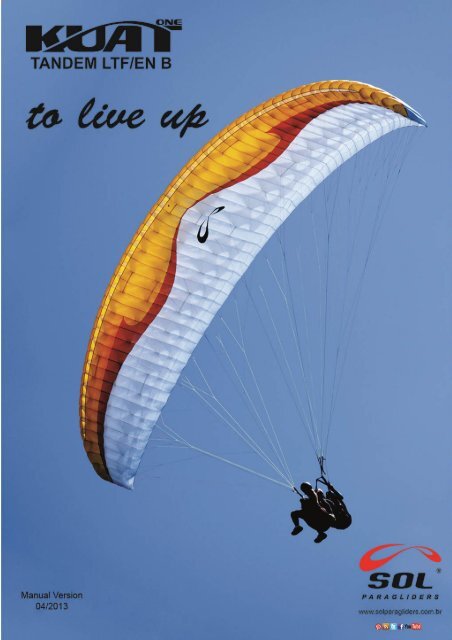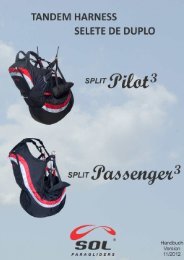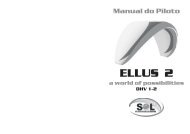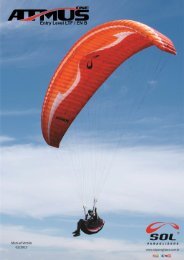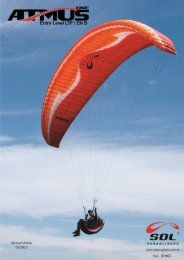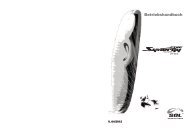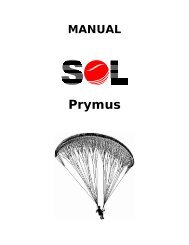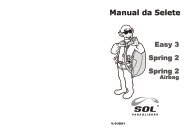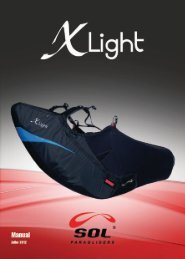Clique here - PDF Manual
Clique here - PDF Manual
Clique here - PDF Manual
- No tags were found...
Create successful ePaper yourself
Turn your PDF publications into a flip-book with our unique Google optimized e-Paper software.
5About SOLFounded in 1991, after six months of research and many visits to severalmanufacturing facilities and suppliers, SOL began its production in partnership with theEuropean brands Condor, Comet and Nova, and became autonomous in 1999 with itsown testing and development centers.From the beginning SOL has adopted the philosophy of utilizing certified designs,manufactured with imported materials of the highest quality by specialized and skilledtrainedstaff.In 1995, the company moved to its current facility, occupying an area of 3.400 m² andhas at its disposal a team of about 140 employees, of which many are pilots. SOLprovides a comprehensive benefits package such as Health Plan, Life Insurance,partnerships with pharmacies, transportation vouchers, incentive getaways toemployees who outperform each month, and education grants.At SOL, we take extreme measures to maintain our machinery and manufacturingequipment current with the world market. This way, we safeguard our accuracyeveryday in the production process, control and assuring the high quality of SOL brandand products throughout more than 70 countries around the world.SOL is one of the few paragliding enterprises worldwide to have its own manufacturingfacilities able to test every new model before making it available to the market, whichfosters the reliability necessary for excellent performance when flying.In early 2004 SOL became certified by DHV, which is the most respected regulatingbody of free-flying worldwide. Its mandate is to make sure its members have thecapacity to reproduce faithfully the certified equipment on an industrial scale. Fewfacilities in the world possess this certification in their manufacturing process. SOL wasone of the firsts to obtain it!This is just one of the great accomplishments of this young and dynamic company,which presently is among the ten major paragliding and accessories manufacturers inthe world!
6PhilosophySOL's philosophy is to introduce products that are considerably better than currentones, in order to guarantee significant advancements in four aspects: Safety,Performance, Ease of Operation and Innovation.Safety: The new product has to offer a level of safety that is at par or better than theone it is replacing.Performance: The new product must perform better than the one it is replacing.Ease of Operation: The new product must display higher levels and better operationalease than the one it is replacing.Innovation: New products must display real benefits to the user, facilitating free-flying,increased safety, or both.The development process and design of every new product begins at the computer.Drawing Software, 2D, 3D modeling and simulation are utilized before the actualmanufacturing of prototypes, in order to ensure greater accuracy in each new design.IntroductionSOL is producing a complete line ofmodern paragliders: from teaching tocompetition and acro all pilots willfind their paragliders.Since we are often in the air - testingour gliders, for fun or breaking worldor national records - it was only logicto develop our own paragliders toassure the evolution in safety, performance, ease of operation and innovation.As in any other product of SOL, we are using always the best and most carefully chosenmaterials, they are granting a long life and a high security standard. All SOLparaglidersare manufactured in our own industrial park.The KUAT is a paraglider with great performance and aerodynamic. The KUAT is atandem glider for qualified pilots. The balance and quality of the turns (efficiency andprecision) and the performance of the KUAT are same as that of a high level glider. Itsmanoeuvrability allows the KUAT to climb the weakest thermals. The KUAT marks theoptimum compromise between handling and performance. This manual offers all theinformation that is need to fly the KUAT and to use his potentials.
7KUAT - To live upThe KUAT is a tandem glider. That means he is built for pilots who want to take othersup into the sky and who are qualified for this adventure. The KUAT is the result of thedifficult job to top the performance. He satisfies the expectation of handling, comfortand security. It should be easy to climb up and enjoy each flight. The KUAT is a gliderwho inspires you to reach out for new experience, performance and long distantflights. His security and stability will please you and your passenger on your way up tothe clouds. Enjoy your flights.KUAT - The ProjectThe KUAT uses a new profile (completely developed by computer simulated models).Having tested different profiles, SOL opted for the optimum balance betweenperformance and stability. The layout of KUAT is entirely new, with a higher aspectratio, which results in a precise handling and more performance.The KUAT combines our performance technology with security. With the newknowledge it was possible to design a glider with an exponential increase inperformance. A combination of new technology and old fashion skills was chosen toincrease the performance without risking the safety:• HPAR - High Project Aspect Ratio: higher A/R in each class.• LCT - Laser Cut Technology: Panels, profiles and parts cutting with Laserequipment.• HTM - High Tech Materials – highest technology materials guarantee durability- Technora Lines, Diax Laminates, Inox Hardware, Polyester of High Tenacity.• 3 Risers System A – B – C row in all levels - less 25% line consumption.• BT - Battens Technology: Flexible battens applied in order to maintain theprofile characteristics in every moment of the flight.• SLS - Seamless Stabilo: The Stabilo’s leading edge has no junctures and isseamless.The KUAT consists of 53 cells and has internal crossed diagonals applied at the profilesto distribute the weight uniformly. This maintains the canopy very shapely and cleansand reduces the induced drag.The KUAT was designed at the new software. Its enhanced design and profile are t<strong>here</strong>sult of our continuous development and refinement process in terms of performancepaired with stability. The improved features of this project permit a large speed rangeand excellent stability.
8KUAT - MaterialsTop / BottomWtx40 PU+Silicon Coating 40 gr/m 2Profiles and Internal Diagonal ReinforcementsPro-Nyl High TenacityNylon Rip-Stop Hard finish 42gr/m 2ReinforcementsNylontabsLinesThe lines are made of technora and polyester they are known for its high grade ofresistance and low stretching overtime. The upper lines are not covered. The mainlines have a diameter of: 2.5 / 2.1 / 1.5 / 1.0 mm. The upper and middle lines have adiameter of: 1,0 / 2.1 mm.RisersFitanew 19 x 2,0 mm Flat Multi 1600 kgQuick LinksAnsung Precision 22 mm Bl 800 kgPulleysSol PL14Suspension systemThe KUAT lines consist of a beige technora core of high resistance to tension and haslow distortion rate, covered by a layer of colored polyester. The set is made ofindividual lines, with sewn ties on both extremities.The upper lines distinguish themselves (next to the inside layer) and the main lines,which are connected to the Quick Links. These, in turn connect to the main lines on therisers. The stabilizers' lines are connected to the same Quick Links.The brake lines come out of the trailing edge, through the master line and are linked tothe toggles, passing through a pulley attached to the 'C' riser.Lines 'A' and the brake lines are of different color in order to facilitate takeoffpreparation.The Quick Links are triangular shaped and are made of inox resin. On the brakes'master lines, t<strong>here</strong> is a mark at the ideal setting point, at which height the toggles areaffixed. This setting should not be altered as it ensures adequate and sufficient pathand room for the toggles in case of emergency situations during flight and landing.Furthermore, in this position the paraglider is not constantly on a stall.
9KUAT - Technical Data38 41ModelZoom 1.18 1.22Cells 53 53Projected Span (m) 11.31 11.69Real Wingspan (m) 13.91 14.38Projected Surface (m 2 ) 31.90 34.10Real Surface (m 2 ) 36.62 39.14Projected A/R 4,01 4.01Real A/R 5.29 5.29Line Diameter 1.0-1.5-2.1-2.5Height (cm) 874 902Take Off Weight* (Kg) 125-180 140-210Maximum Profil (m) 3.25 3.36Minimum Profil (m) 0.71 0.73Weight (kg) 9.2 9.7Places 2 2Certification EN/LTF B B* Take Off Weight: Pilot , Glider, Harness and equipment + passenger and harness.The identification and information tag is found at the center of the wingtip.
10KUAT - Risers and TrimmerThe KUAT has 4 riser´s on each site, including A1. All A lines are attached to the A riser.The B lines and stabilo lines are attached to the B riser. The C riser leads to all the Clines. The brake lines are going to the pulley which is attached to the C riser.Risers:1. Connection tandem spreads2. Trimmer3. Magnetic clip4. Swivel5. Brake pulley6. ToggleTrimmer open (acelerated) Trimmer closedWarning• The application of the trimmer results in an increase of velocity.• The application of the trimmer decreases the angle of attack andturns the paraglider more vulnerable for collapses.• Never let go of the toggles !• The trimmer of the KUAT could help to define the velocity on takeoff. Takingoff with less weight could be done with trimmers open.
11KUAT - Tandem spreadsThe pilot is connected behind the passenger onthe shorter end of the tandem connection thusreaching easier the control handles and risers. Incase of a big weight difference between pilot andpassenger, the tandem connection offers variouspoints to fix the passenger always maintainingthe ideal position of balance.Comparing with a mono glider, the risers of theKOALA are shorter in order to compensate theheight of the tandem connection that connectsthe passenger with the pilot.RisersA1 - EarsD - ToggleE - TrimmerTandem spreads1. Main carbine2. Rescue system connection3. Pilot4. Passenger heavier than pilot: position 45. Passenger with similar weight: position 56. Passenger lighter than pilot: position 6
12KUAT - HarnessAny harness of type ABS are recommended for the KUAT, tested with large clips set at42 cm and 47 cm heights from the board, depending on the harness size. Care must betaken because the large clips height affects the brake position when set at 'normal'.The regulated distance between the large clips (adjustable at the chest) is 44 cm.Variations of more than 5 cm above these ones will alter the fundamentalcharacteristics of the canopy and are potentially dangerous.SOL give free together all gliders and harnesses, a Measuring Tape to help pilots tocheck the distance between carabineers.WarningCross straps may jeopardize flying and do not improve safety.
13KUAT - FlightTakeoff WeightThe KUAT has been certified for a defined weight range. If your weight range fallsbetween two sizes, we recommend the following:- If you desire better speed, accurate commands, and if you usually fly over mountainsand/or extreme conditions, you should choose to fly near the middle to maximumsuggested weight.- If you desire a better sink ratio, and if you usually fly above flat elevations, and lightconditions, you should choose to fly near the minimum suggested weight.First FlightA careful First Flight is necessary with every paraglider, the KUAT is no exception. Thisflight must take place on a practice hill.After unpacking the paraglider and laying out it in a horseshoe shape position, thefollowing steps must be taken:• The paraglider must be laid out in such a way that, when tension is applied torisers ‘A’, the canopy center should be extended before the extremities. Thisallows for an easy takeoff with good directional stability.• Special attention must be taken to the wind’s direction upon the lifting of thecanopy, so that the two halves are inflated symmetrically.• All lines must be organized and completely free of any entanglements. Specialattention must also be given to the lines ‘A’, which must be free right from therisers ‘A’ (with the red mark) to the canopy.• Same priority and care must be given to the brake lines, which must also becompletely free and without any possibility of entanglement on any obstacleduring takeoff.• All lines should be checked and all the risers in appropriate order. When therisers are aligned and not twisted, the brake lines will be free from the pulleys(on the rear risers) to the canopy’s rear edge.• It is extremely important that no entanglements nor bunched lines are present.• Any line going under the canopy or tie may result in disastrous consequences.• Before and after each flight the lines, risers and canopy must be checked forany possible damage.• In case t<strong>here</strong> is any damage present, as insignificant as it may be, the canopyshould not be flown!WarningIt is not advisable to fly the KUAT in rainy days or with a wet paraglider,since the in-flight maneuvers become more sensitive and a reservedeployment may occur upon exiting a B-Stoll or in the event of excessiveusage of breaks.
14Takeoff Pre-flight Checklist - DO NOT FORGETTakeoff• Make sure reserve is OK! Opening device and pins activated?• Helmet?• Carbines closed?• Harness – Connected all Locks closed?• ‘A’ risers in hands?• Untangled brakes in hand?• Are you in the center of the canopy?• Takeoff path is clear?• Paraglider and pilot aligned with the wind?• Airspace ahead of takeoff area is clear?• Distance between carbines is correct?Forward TakeoffIt’s very easy to fly the KUAT. When ready to takeoff, the pilot must take risers ‘A’, ‘A1’together with the toggles. In order to differentiate between the lines, line ‘A’ and risers‘A’ inclusive are marked with a different color.Before takeoff, a last check is required to ensure all the equipment is laid out properly.The arms must be extended to the side, as if they are extensions of risers ‘A’. Adecisive run allows for a quick and stable inflation. Canopy overtakes are not common.After the initial inflation momentum, the pilot must keep the tension forward on risers‘A’ (pushing them ahead, and not pulling them downwards), until the canopy is aboveyour head. At this point, the brakes must be carefully activated, ensuring room for thepossibility of directional changes. A move to underneath the center of the paraglider isthe best method for corrections, provided t<strong>here</strong> is room for it. The pilot glances at lastupwards to ensure the canopy is properly located above, completely unobstructed andinflated. At this point, the pilot decides whether or not to takeoff.Reverse TakeoffReverse takeoffs in strong wind conditions are also very easy to execute. Due to risk oftakeoff with entangled lines (twist), it is highly recommended to take some time andpractice reverse takeoffs on a small, leveled hill initially.Installation of tow release and auxiliary adaptationThe KUAT can be used for towed flight as long as is connected to the towed flightsystem (Tow release). It must be connected to the same carabineers that join theharness with the paraglider. It is activated through an activator that is strategicallylocated and when is pulled it releases the equipment to fly. During the taking off it’snecessary to avoid a small angle of the cable with the ground.A taking off with tow release help needs instructions and appropriate procedures.Make sure that you have the necessary knowledge and that the operation is made in asafe and correct way.
15PerformanceThe KUAT in its normal flight, performs better with the hands lifted, applying 25 cmthe canopy enters safely the minimum speed range. In order to accelerate (6 - 8 km/h)use the Trimmer.Thermaling and SoaringIn turbulent conditions, the paraglider must be flown with the brakes softly applied. Anincrease in angle of attack is achieved by this measure, resulting in greater canopystability.The pendulum effect back and forth must be avoided! The canopy must remain on topof the pilot. For this purpose, the speed must be increased by releasing the brakesupon entering a thermal (depending on its intensity) or braking on exit. This is part ofthe basic technique on active flying.During flights over the lift, it is highly recommended a minimum height of 50m be kept,for safety reasons.It is extremely important to know and respect flying regulations, especially so whenthe airspace within close proximities of canyons is shared among several pilots, w<strong>here</strong>last minute anti-collision maneuvers are not executable.TurnsThe KUAT is very sensitive, responding instantly to turn commands. Leveled turns canbe achieved with the shifting of weight on the risers with minimum altitude loss. Acombination of weight shifting and breaking technique is the most efficient way ofexecuting turns in any situation. The given brake utilized determines the radius ofturns.By activating the brakes on the outside edge of the turns, as well as applying maximumweight shifting on the risers, the efficiency and resistance to collapse in turbulences (atthe edge of thermals) is increased.In case it becomes necessary to perform turns in a constrained space with the KUAT,we recommend you to release the outside brake in the given turn and pull a little morethe brake on the inside of the turn.The KUAT glides best when no brakes are applied.WarningBy pulling either brake too strongly or suddenly, t<strong>here</strong> is a danger ofcreating a negative spiral!Accelerated FlightIt is recommended to use the accelerator when flying against the wind or indescending current zones. Due to a decreased angle of attack, the canopy may collapseeasier than when set at the normal position. The pilot must remember that the higherthe speed, the more dynamic the collapse response or symmetric closing will be.
16Flight in turbulent conditionsIn turbulent conditions it is not recommended to fly the glider with full speed, causethe KUAT is than more sensitive to deformation and closing. The pilot must rememberthat the higher the speed, the more dynamic the collapse response or symmetricclosing will be.WarningThe KUAT requires active flying in turbulences! This can avoid canopyclosings and deformations.Active flightFor best performance during your flight, it is important to be always sensitive to whatyour canopy is trying to communicate. The key elements of active flying are theadvancements and tension control.When the canopy moves ahead of you, carefully apply the brakes, so that the canopyreturns to be above you, and if the canopy moves behind you, you must release thebrakes.Flying with the brakes lightly applied (+ - 20 cm) allows the canopy to fly slightlybehind. In turbulent circumstances the internal paraglider tension may change, whichyou will feel on the brakes. The idea is to maintain a constant tension, and in case youfeel loss of tension, apply the brake.These adjustments will make for a more controlled flight, and help in eliminating thepossibility of collapse.Avoid flying excessively with the brakes on because you might brake to the point ofstopping the canopy from flying. Always consider your aerodynamic speed. Yourmovements can be symmetric or asymmetric and both or one brake can be applied.We suggest that you do ground practice runs and advancing simulations. Tension losscan be simulated well on the ground.WarningNeither pilot nor any paraglider are immune to collapses; t<strong>here</strong>fore activeflying will decrease the chances of happening. When flying in turbulentconditions, be more active and avoid great advancements of the canopy byanticipating yourself too quickly with your response movements. Always maintainaltitude awareness and do not get into excessive commanding mode. We advise you tomaintain brake tension and avoid flying in extreme turbulent conditions.
17LandingIt's very easy to land with the KUAT. The final approach stage must be done in straightline upwind. During this final glide, the paraglider must be decelerated slowly and atabout 1 m from the ground the pilot must stall the canopy, according to theconditions.With a strong nose wind, the pilot should break only slightly or eventually don't evenbrake at all, and utilizing just the risers 'C' to de-inflate and overcome the canopy afterthe landing. By breaking during a landing in strong wind conditions, you may exposethe canopy to the wind, which could lead to the pilot being dragged backwards.The final approach must be done always in a straight line. Sharp and alternating turnsmay produce a dangerous pendulum movement close to the ground.Motorized Flight and Acrobatic FlightThe KUAT has not been designed for motorized flight, or acrobatics. Although it hasbeen successfully used for these purposes by some pilots.KUAT - Fast descent maneuversWarning• All fast descent maneuvers must be executed in light conditions andat sufficient altitude, so that they can be performed as necessaryunder extreme flying conditions.• 'Full Stalls' and negative spirals must be avoided, regardless of the paragliderbeing flown. Incorrect recoveries and exits can result in disastrousconsequences.• The best flight technique is to fly safely and correctly. This way you will neverneed to descend rapidly!EarsBy pulling simultaneously the external riser 'A1' atabout 18 cm, the canopy tips will close. The canopyremains completely maneuverable through theactivating of unilateral brakes or the shifting of weighttowards the risers, flying at a fast descending rate (up toapproximately 5m/s). In order to recover, the pilot mustrelease the external riser 'A1' lines. Usually the canopyre-opens by itself, but the pilot can assist with a longand quick pumping.WarningSOL does not recommend combining of ears and spirals, as this mayexceed the allowable load.
18Positive SpiralWhen the pilot activates just one brake, slowly and progressively, the KUAT inclinessideways in a sharp angle and enters a steep and quick turn, which may become apositive spiral.During a spiral the rotation radius can be controlled by the greatest or smallest forceapplied to the inside brake. In order to come out of it, the pilot must release the brakeslowly and shift his/her weight lightly to the outside of the turn. A sudden exit mayresult in an exaggerated momentum forward of the canopy, and collapsing it. For thisreason, on exiting the last turn, the inside brake of a given turn must be softly appliedagain.In case the canopy collapses during this process, the spiral must be counter-acted, asthe active canopy area will be reduced.Spirals carry a high rate of descent. T<strong>here</strong>fore high accelerations (G) make it impossibleto hold them for an extended period of time. The spiral force may cause the pilot tofaint and to lose flying controls, and crash. Furthermore, they will exert a lot of forceand affect the pilot and equipment alike.The pilot should never exercise this maneuver in turbulences or with wide lateralangles. In windy conditions, the pilot must be aware of oscillations during themaneuver.Warning• Never combine ears with spirals. The canopy active area reductionplus the 'G' force, by the centrifugal effect, may result in lineand/or canopy damage.• Exiting of any spiral at great speeds must be piloted.• This maneuver requires high altitudes (at least 600 meter over ground) and isdangerous due high descent ratio pilot can lose the altitude reference. Neverdo this maneuver without sufficient experience.B-StollTo induce a 'B-Stall', the pilot must pull the risers 'B'simultaneously, between 15 and 20 cm. T<strong>here</strong> will be ashift of air flow on the outer layer and the canopy willinitiate a parachutal phase. By releasing the risers 'B'quickly the airflow recoils on the outer layer and thecanopy returns to its normal flight position. In case thecanopy does not recover to normal flight, refer to thesection on Wraps. The momentum of return creates aforward motion by the canopy. We recommend avoiding braking the paraglidereliminating the possibility of a parachutal stall. The load applied on the 'B' lines duringthis maneuver is not beneficial to your paraglider. Use this maneuver only inemergencies. In the event risers 'B' are pulled too quickly or too deeply, a horseshoemay occur towards the front. In order to regain normal flight, the pilot must apply thebrakes lightly.
19KUAT - Behavior in extreme maneuvers and collapsesWarningExtreme maneuvers must be executed under the supervision of a qualifiedinstructor, on safe courses and with the entire infrastructure available forabove ground and water flying!Lateral Asymmetric ClosingLike any other canopy, a negative angle of attack will result in a closing. In order tomaintain directional control upon a lateral asymmetric closing, the brakes must beapplied on the open side.In case of a major closing, the amount of braking must be well graduated, in such wayto avoid the airflow displacement (stall) on the open section of the canopy.To facilitate the canopy re-inflation during a collapse, the steps above must befollowed in conjunction with a long and slow brake pumping action (2 seconds) withthe toggle on the closed side. The shifting of weight on the opposite side riser of theclosing will also assist with the re-inflation and increase safety, requiring less brakeaction and keeping away from the stall point.In case the pilot does not compensate with the brakes, the KUAT in most situationswill inflate by itself even in major asymmetric collapses. The KUAT can make acomplete turn and in the event it does not open on its own, without action, theparaglider will begin a positive spiral. The pilot must lightly apply the brake on theexternal side to stop a spiral and at the same time shift his/her weight on the sameside until the canopy is stabilized. Exactly at this stage of pendulum effect under thecanopy, it is important that the pilot controls carefully the amount of force applied onthe brakes, and often it is needed to decrease the force. Once a straight flight isachieved, the closed side can be re-inflated by the pumping action.WarningIf the pilot does not actively terminate the spiral, it will continue all theway to the ground!
21Full StallTo create a ‘Full Stall’, the pilot must pull both brakes to the end, and hold them tightlyin this position. In this situation, the KUAT flies in most times on reverse, in a forwardhorseshoe shaped tie. The canopy must be stabilized before the procedure for normalflight re-entry is initiated. Any attempt of recover during the beginning stages of a stall,when the paraglider reverses suddenly can result in a sudden push forward of thecanopy.When recovering from a 'Full Stall', both brakes must be released slowlysimultaneously and symmetrically (> = 1 second). The KUAT will move forwardgradually and begin normal flying.An asymmetric recovery (releasing one brake before the other) of a 'Full Stall' isutilized only by test pilots to simulate a paraglider being expelled out of a thermal andmust not be attempted by pilots!Negative TurnsTo induce a fast Negative Turn out of normal velocity (LTF) or starting from theminimum speed (EN), the pilot must pull tightly and quickly one toggle right to the endof it.During the negative spiral, the canopy rotates relatively fast around its center, with itsinner side flying backwards.When entering an unintentional Negative Turn, the pilot must recover as soon as it isnoticed by releasing the brake slightly so that the canopy will accelerate and returns toa stable flight, without losing too much altitude.When a negative turn is intentionally prolonged, the KUAT accelerates forwardasymmetrically. A frontal asymmetric closing should not be under-estimated. Torecover from an intentional negative spiral, the pilot must release the pulled brake andpay close attention to a strong canopy surge ahead.Emergency FlyingIn case braking controls are impossible, the canopy can be drivenby utilizing risers 'C' and eventually land. Pay close attention to thelength of the command, which should be shorter than brakingcommands.WingoverIn order to perform a 'Wingover' the pilot must generate a strong pendulum effect byalternating turns on both sides. A complete closing of the canopy is possible.WarningA turn with an incline beyond 60º is considered acrobatic.
22KUAT - Up-keep, maintenance and repairscome.WarningA good maintenance will extend the life of your KUAT for many years toStorageThe paraglider must be stored dry, in a dry place, protected from UV light and awayfrom chemical products.BackpackYour backpack was designed with comfort and practicality in mind. It´s format allowsfor good content distribution. Shoulder straps and back support are padded so thatcomfort is not compromised during walks. For larger equipment capacity, yourbackpack has an expandable compartment, which can easily be enlarged withoutsacrificing the layout. Two different pocket sizes at the front allow` for easy storage ofsmall articles.FoldingBy following each step properly, you will be helping to preserve the life span of yourequipment:• Open the canopy completely on the ground.• Place all the lines spread by the inner layer and risers in the middle outside thecanopy on the trailing edge.• We recommend folding your paraglider like an accordion. This will keep theprofile reinforcements (Mylar/Carbon) from being crumpled and/or folded. Byusing this folding method, the paraglider will keep its takeoff and flightcharacteristics for longer.• Keep folding to approximately 50 cm.• Remove all the air by sliding your hand from the trailing edge to the leadingedge.• Make sure the volume is a little smaller than the protection bag.• Avoid multiple folds at the same place.Steps:1. Open the canopy completely.2. Packing the glider “accordion wise” as show in thefigures.3. Place each profile reinforcement over thecorresponding cell.4. Bring together the two parts and roll the canopy upwithout compressing too strongly.
23CleaningCleaning must be performed only when it is absolutely necessary. We recommend theuse of water only with a smooth sponge or cloth. Do not use any chemical product,since it will damage the material permanently.PulleysIt is important you keep pulleys lubricated because in case theydo not work may consume the speedy handle or axle, applyparaffin or lubricant spray, read carefully about the lubricant toavoid spots and fabric consume. Do not apply on the sewinglines.WarningWhen buying the lubricant make sure that this product do not attack thematerial properties. This may affect the fabric and lines resistance.Recommendations for a long lifeThe KUAT fabric is made mainly out of Nylon, which like any othersynthetic material is sensitive to UV light radiation, causing it todecompose, losing its mechanical resistance, and thus increasing itsporosity. For this reason, the unnecessary exposure to sun light,which carries a high UV radiation level in high altitudes must beavoided. It is highly recommended to leave the paraglider storedaway and well protected when it´s not being used.The KUAT lines are made of a aramide (technora), with a Polyester cover. Individualline overloads beyond the normal range in flight must be avoided, because anexcessive deformation of the line is irreversible, and becoming permanent. The sameway, folding and creasing the lines must be avoided, specially the main lines. Neverstep over the lines or canopy, above all on hard surface.The canopy must be opened only on a clean surface area, since dirty can penetrate inthe canopy's fiber, shorten the lines or spoiling the fabric. The lines must be kept fromany entanglements on takeoff to prevent excessive deformation.Avoid storing the paraglider for long periods in areas with high humidity or heat, thiscauses premature aging of the materials. Keep away sand, stones or snow fromentering the canopy cells because any weight on the trailing edge slows the canopydown, possibly creating a stall, furthermore, sharp corners may cut the fabric.During takeoffs and landings in windy conditions, a run-away canopy may hit theground strongly and the shock may rupture the material.In case of line entanglement the brake lines may peel-off or a main line may get cut bya brake line, due to friction.On landing, avoid letting the Leading Edge fall forward and downward towards theground because this may damage the materials that form the front of the paragliderand/or rip the sewn areas.
24The manipulation of the paraglider during ground takeoff, or a lot of wind speed upthe aging process of your equipment.After a tree or water landing, the lines must be checked andtested.In case of salt-water contact, the paraglider must be soakedand washed with fresh water. Salt water might decrease thelines' resistance even if soaked with fresh water. The linesmust be changed after contact with salt water.Never dry the paraglider directly under the sun. This mustbe done in a shaded area. After drying send the paragliderfor inspection to the manufacturer or distributor.A Line Plan can be found in this manual or can be obtainedwith the manufacturer or distributor.After an accident or long time without using the paraglider must be checked.It is recommended that the canopy should not folded in the same symmetric positionin relation to the center, this way the center cell will not be always exposed, t<strong>here</strong>forekeeping the central cell from fatigue overtime.Avoid storing the glider near fire and/or sharp objects. Any contact with acids shouldbe avoided. In case of any doubts ask your distributor.WarningYour KUAT was designed, tested and certified to perform the best. Anyalteration of your paraglider will nullify your certification and jeopardizeyour safety. For these reasons we strongly recommend you to avoid altering anythingon your paraglider.
25Inspection and repairsThe first inspection check is mandatory completing 24 months or 100 flights,whichever comes first. After the first inspection any wing has to be checked yearly orat each 100 flights, whichever comes first.In any of these inspections may occur that a shorter period of time for the nextinspection will be defined (f. ex. 6 months or 50 flights).In case of excessive use (permanent spirals and other extreme maneuvers) the periodof inspection has to be shorter.It is of utmost importance to follow these guidelines. Without performing themandatory inspections, the paraglider loses its certification and the respective SOLwarranty becomes null and void.Always check your equipment after an incident or in case the canopy has been storedfor a long time.Repairs must be performed only by the manufacturer, distributor or authorizedpersonnel. Minor repairs could be handled by yourself, although we recommend thatrepairs should be performed by the manufacturer or authorized personnel. They havethe necessary materials and tools to maintain your glider. Replace materials only withthe originals. Using any other the glider will lose his certification.TearsAlong with your kit you get small adhesives for repair. Small tears up to 10 cm awayfrom the line points may be fixed by you. Beyond that we advise you the maintenancebe made by the manufacturer or by the registered workshop.• Clean the spot w<strong>here</strong> the adhesive will be applied with a humid cloth.• It must be at least 2,5 cm more of the adhesive than the tear.• Make the edges rounded to avoid to unglue after is glue.• Apply on both sides of the tear.Line breakageAlong with your kit you get a 1.1 thickness line to make a little repair. When you repairwe advise you to sew the unsowed point after you check the measure. Do not knotbecause it may diminish up to 80 % of the line resistance.SealingAlong with your kit you get sealing for the carabineers. Do not leave your riserswithout them because they avoid the movement of the screw nut making it impossibletheir opening.
26ZipperThe backpack zipper must open and close softly. If t<strong>here</strong> isany difficulty to move it you must apply paraffin or a spraylubricant to diminish the attrition among the components.You will notice the difference whenyou move it.It is possible most of the times you fixby yourself the zipper. In case it doesnot close any more just pull it until the beginning of the positionand with a pliers press both sides of the zipper.Nature and environmentPlease fly in accordance to preserve nature and environment.KUAT - Out of useIf your glider gets out of use remember it cannot be recycled. Please give it to yourdistributor or your flying-school, they should know how handle it.
27KUAT - WarrantyEvery paraglider manufactured has a Warranty of 3 Years or 300 Hours of Flight,whichever comes first.Warranty Terms1. This warranty is valid for all SOL Paragliders with LTF, EN or AFNORcertification, rated for leisure use only.2. This warranty does not include paragliders rated for professional use (school,competitions, aerobatics, etc).3. This warranty is defined as repair or substitution of the defective paragliderparts determined by the producer.Warranty Pre-requisites1. A three-copied filled-out form: One copy to be sent to SOL Paragliders within30 days after purchase; one copy to the sales person and one copy to thepurchaser.2. All flights must be logged providing information on date, place and length offlight.3. The equipment must be kept in accordance with the instructions provided inthis manual. All the storage, folding, cleaning and care instructions must becarefully taken.4. Maintenance and inspections can only be performed by the manufacturer orauthorized shop and must be properly documented.5. The first inspection check is mandatory completing 24 months or 100 flights,whichever comes first. After the first inspection any wing has to be checkedyearly or at each 100 flights, whichever comes first. In any of these inspectionsmay occur that a shorter period of time for the next inspection will be defined(f. ex. 6 months or 50 flights). It is of utmost importance to follow theseguidelines. Without performing the mandatory inspections, the paraglider losesits certification and the respective SOL warranty becomes null and void.6. The final decision on exchanging or repairing the equipment will be decided bySOL Paragliders.7. All shipping and handling expenses are paid by the owner.8. The corresponding equipment has to be sent to SOL Paragliders in thefollowing way:a) Accompanied by a copy of all inspections and a log of all flights.b) Accompanied by a copy of the SOL Paragliders warranty form.
28This warranty does not cover• Any alterations on original fabric colors, lines and risers.• Any damage caused by chemical products, sand, friction, cleaning products orsalt water.• Any damage caused as a result of errors during operation of the Paraglider,incidents or emergency situations.• Any damage caused by inadequate operation of the Paraglider.• Paragliders that may have been subjected of any alteration from the originaldesign and without proper permission from SOL Paragliders.• Damages caused by inappropriate transport, storage or settings of theparaglider.• Damages caused by the use of not compatible components with the paraglider.• Damages caused by the use of inappropriate packaging for the transport.• Paragliders without original identification label and serial number.• Handling inadequately to the instructions given in the owner´s manual.Final wordsSafety is the major theme of our sport. In order to fly safely, pilots must train, study,practice and be alert to the dangers around us.In order to achieve excellent safety levels, we must fly regularly as much as possible,don't go beyond our limitations and avoid exposing ourselves to unnecessary dangers.Learning to fly is a slow process and takes years, so don't pressure yourself. Ifconditions are not favorable, keep your equipment stored away.Don't overestimate your skills and be honest with yourself. Every year we see manyaccidents which in most cases could be prevented with a minor adjustment.We are a part of the community in which we live: friends, family and even people wedon't necessarily know worry about us. Our obligation towards this community is tokeep ourselves healthy and that at each landing we will be one landing happier thanbefore. We fly so that we can feel more alive.We wish you good and safe flights with your KUAT.
29KUAT - AppendixKUAT 38 - Certification
KUAT 41 - Certification30
KUAT - Overall Plan31
KUAT - Line Plan32
33KUAT - Flight LogSize:Serial number:Date of purchase:Purchased from:Date Duration Site Flight Details
34KUAT - InspectionOwner:Address:Phone:Date:CellsDacron re-enforcementsTopBottomLeading EdgeTabsUpper A-LinesUpper B- LinesUpper C- LinesMidle A- LinesMidle B- LinesMidle C- LinesA-Main-LinesB- Main-LinesC- Main-LinesStabilo LinesBrake-LinesInternal Cell WallsCross PortsMaillon RapidesTogglesRisersPorositätstestConditionObservations:


